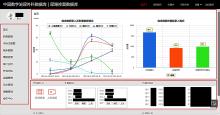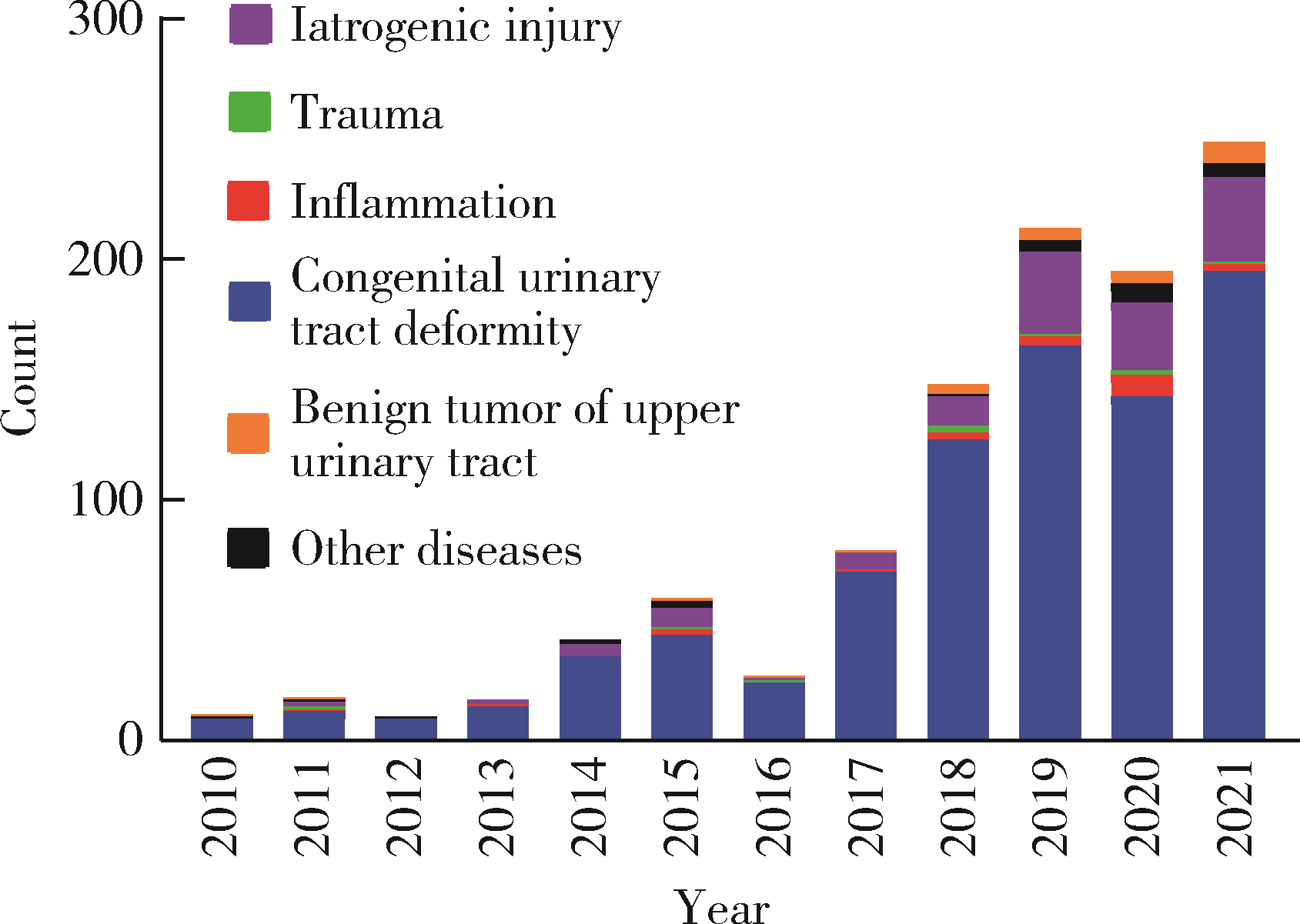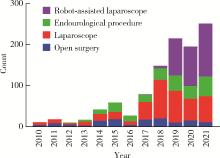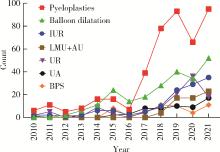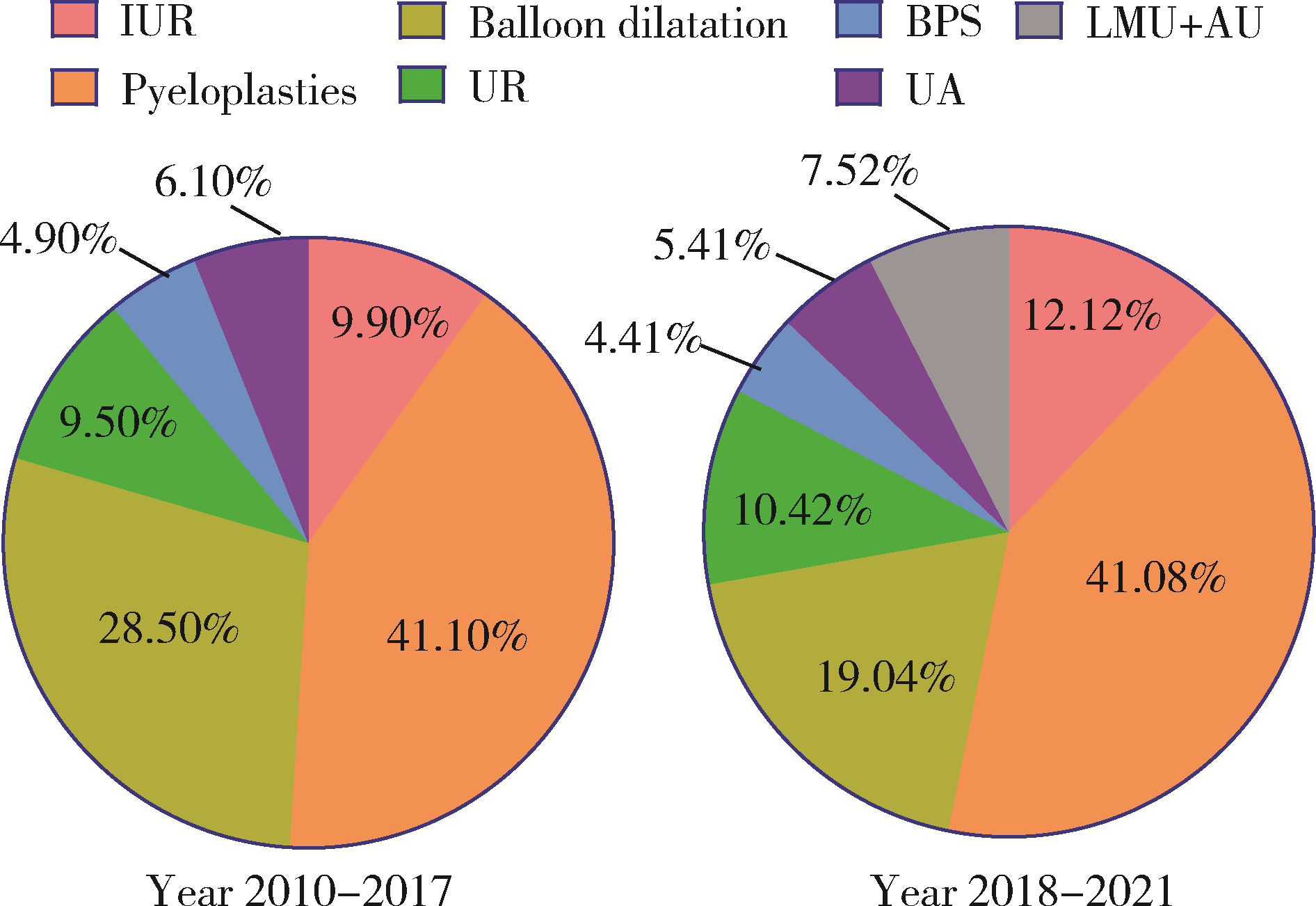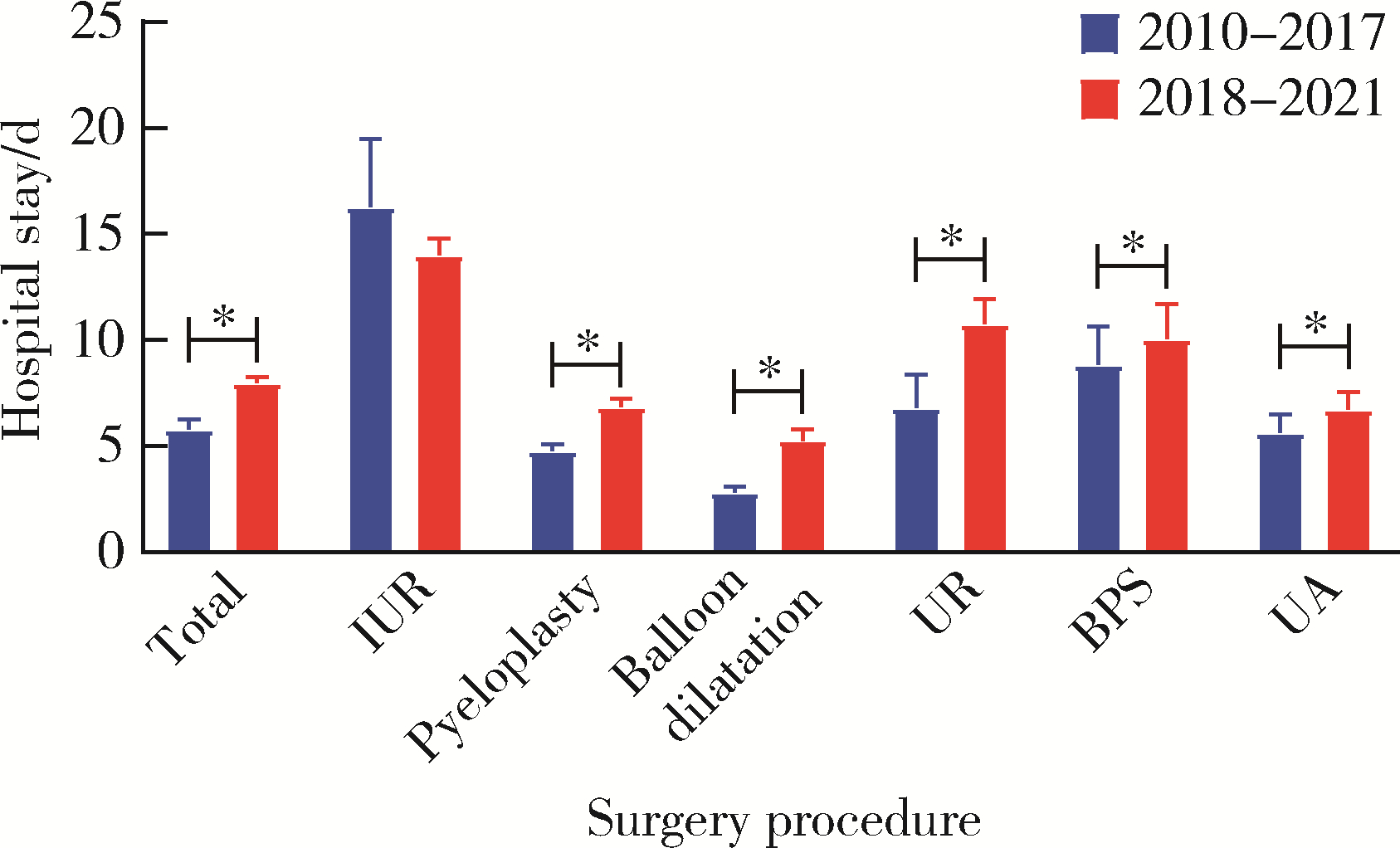Journal of Peking University (Health Sciences) ›› 2022, Vol. 54 ›› Issue (4): 692-698. doi: 10.19723/j.issn.1671-167X.2022.04.018
Previous Articles Next Articles
Trends in upper urinary tract reconstruction surgery over a decade based on a multi-center database
Wei ZUO1,Fei GAO1,Chang-wei YUAN1,Sheng-wei XIONG1,Zhi-hua LI1,Lei ZHANG1,Kun-lin YANG1,Xin-fei LI1,Liang LIU2,Lai WEI2,Peng ZHANG3,Bing WANG4,Ya-ming GU4,Hong-jian ZHU2,Zheng ZHAO1,*( ),Xue-song LI1,*(
),Xue-song LI1,*( )
)
- 1. Department of Urology, Peking University First Hospital; Institute of Urology, Peking University; National Urological Cancer Center, Beijing 100034, China
2. Department of Urology, Beijing Jiangong Hospital, Beijing 100054, China
3. Department of Urology, Emergency General Hospital, Beijing 100028, China
4. Department of Urology, Miyun District Hospital (Miyun Hospital, Peking University First Hospital), Beijing 101599, China
CLC Number:
- R691.6
| 1 |
Stief CG , Jonas U , Petry KU , et al. Ureteric reconstruction[J]. BJU international, 2003, 91 (2): 138- 142.
doi: 10.1046/j.1464-410X.2003.03060.x |
| 2 |
Zhu W , Xiong S , Xu C , et al. Initial experiences with preoperative three-dimensional image reconstruction technology in laparoscopic pyeloplasty for ureteropelvic junction obstruction[J]. Transl Androl Urol, 2021, 10 (11): 4142- 4151.
doi: 10.21037/tau-21-590 |
| 3 |
Yuan C , Wang J , Cheng S , et al. Robotic ureteral reimplantation for the management of ureterovaginal fistula: Four cases at a single center[J]. Transl Androl Urol, 2021, 10 (10): 3705- 3713.
doi: 10.21037/tau-21-454 |
| 4 |
Yang K , Fan S , Wang J , et al. Robotic-assisted lingual mucosal graft ureteroplasty for the repair of complex ureteral strictures: Technique description and the medium-term outcome[J]. Eur Urol, 2022, 81 (5): 533- 540.
doi: 10.1016/j.eururo.2022.01.007 |
| 5 |
Wang J , Xiong S , Fan S , et al. Appendiceal onlay flap ureteroplasty for the treatment of complex ureteral strictures: Initial experience of nine patients[J]. J Endourol, 2020, 34 (8): 874- 881.
doi: 10.1089/end.2020.0176 |
| 6 |
Fan S , Yin L , Yang K , et al. Posteriorly augmented anastomotic ureteroplasty with lingual mucosal onlay grafts for long proximal ureteral strictures: 10 cases of experience[J]. J Endourol, 2021, 35 (2): 192- 199.
doi: 10.1089/end.2020.0686 |
| 7 |
Li X , Wang X , Li T , et al. Cine magnetic resonance urography and whitaker test: Dynamic visualized and quantified tools in ileal ureter replacement[J]. Transl Androl Urol, 2021, 10 (11): 4110- 4119.
doi: 10.21037/tau-21-507 |
| 8 | Li X , Yang K , Zhu W , et al. The whitaker test in the follow-up of complex upper urinary tract reconstruction: Is it clinical useful or not[J]. Urol J, 2021, 19 (1): 56- 62. |
| 9 | Ding G , Li X , Fang D , et al. Etiology and ureteral reconstruction strategy for iatrogenic ureteral injuries: A retrospective single-center experience[J]. Urol Int, 2021, 105 (5/6): 470- 476. |
| 10 |
de Onis M , Blössner M . The world health organization global database on child growth and malnutrition: Methodology and applications[J]. Int J Epidemiol, 2003, 32 (4): 518- 526.
doi: 10.1093/ije/dyg099 |
| 11 |
Jacobs JP , Lacour-Gayet FG , Jacobs ML , et al. Initial application in the sts congenital database of complexity adjustment to evaluate surgical case mix and results[J]. Ann Thorac Surg, 2005, 79 (5): 1635- 1649.
doi: 10.1016/j.athoracsur.2004.09.065 |
| 12 |
Kakeji Y , Yamamoto H , Ueno H , et al. Development of gastroenterological surgery over the last decade in japan: Analysis of the national clinical database[J]. Surg Today, 2021, 51 (2): 187- 193.
doi: 10.1007/s00595-020-02075-7 |
| 13 |
Bowdish ME , D'Agostino RS , Thourani VH , et al. Sts adult car-diac surgery database: 2021 update on outcomes, quality, and research[J]. Ann Thorac Surg, 2021, 111 (6): 1770- 1780.
doi: 10.1016/j.athoracsur.2021.03.043 |
| 14 |
Kwoh YS , Hou J , Jonckheere EA , et al. A robot with improved absolute positioning accuracy for ct guided stereotactic brain surgery[J]. IEEE Trans Biomed Eng, 1988, 35 (2): 153- 160.
doi: 10.1109/10.1354 |
| 15 |
Binder J , Kramer W . Robotically-assisted laparoscopic radical prostatectomy[J]. BJU Int, 2001, 87 (4): 408- 410.
doi: 10.1046/j.1464-410x.2001.00115.x |
| 16 |
Rosero EB , Kho KA , Joshi GP , et al. Comparison of robotic and laparoscopic hysterectomy for benign gynecologic disease[J]. Obstet Gynecol, 2013, 122 (4): 778- 786.
doi: 10.1097/AOG.0b013e3182a4ee4d |
| 17 |
Yates DR , Vaessen C , Roupret M . From leonardo to da vinci: The history of robot-assisted surgery in urology[J]. BJU Int, 2011, 108 (11): 1708- 1713.
doi: 10.1111/j.1464-410X.2011.10576.x |
| 18 |
Autorino R , Porpiglia F , Dasgupta P , et al. Precision surgery and genitourinary cancers[J]. Eur J Surg Oncol, 2017, 43 (5): 893- 908.
doi: 10.1016/j.ejso.2017.02.005 |
| 19 |
Leal Ghezzi T , Campos Corleta O . 30 years of robotic surgery[J]. World J Surg, 2016, 40 (10): 2550- 2557.
doi: 10.1007/s00268-016-3543-9 |
| 20 |
Andolfi C , Adamic B , Oommen J , et al. Robot-assisted laparoscopic pyeloplasty in infants and children: Is it superior to conventional laparoscopy?[J]. World J Urol, 2020, 38 (8): 1827- 1833.
doi: 10.1007/s00345-019-02943-z |
| 21 |
Crocerossa F , Carbonara U , Cantiello F , et al. Robot-assisted radical nephrectomy: A systematic review and meta-analysis of comparative studies[J]. Eur Urol, 2021, 80 (4): 428- 439.
doi: 10.1016/j.eururo.2020.10.034 |
| 22 |
Deng T , Liu B , Luo L , et al. Robot-assisted laparoscopic versus open ureteral reimplantation for pediatric vesicoureteral reflux: A systematic review and meta-analysis[J]. World J Urol, 2018, 36 (5): 819- 828.
doi: 10.1007/s00345-018-2194-x |
| [1] | Silu CHEN, Haiju WANG, Yucai WU, Zhihua LI, Yanbo HUANG, Yuhui HE, Yangyang XU, Xuesong LI, Hua GUAN. Etiological analysis of hydronephrosis in adults: A single-center cross-sectional study [J]. Journal of Peking University (Health Sciences), 2024, 56(5): 913-918. |
| [2] | Yicen YING,Yicong DU,Zhihua LI,Yiming ZHANG,Xinfei LI,Bing WANG,Peng ZHANG,Hongjian ZHU,Liqun ZHOU,Kunlin YANG,Xuesong LI. Robot-assisted laparoscopic ureteroplasty with buccal mucosa graft for complex ureteral stricture [J]. Journal of Peking University (Health Sciences), 2024, 56(4): 640-645. |
| [3] | Jian-xun MA,You-chen XIA,Bi LI,Hong-mei ZHAO,Yu-tao LEI,Xi BU. Choice of immediate breast reconstructive methods after modified radical mastectomy [J]. Journal of Peking University (Health Sciences), 2023, 55(4): 612-618. |
| [4] | LAN Lin,HE Yang,AN Jin-gang,ZHANG Yi. Relationship between prognosis and different surgical treatments of zygomatic defects: A retrospective study [J]. Journal of Peking University (Health Sciences), 2022, 54(2): 356-362. |
| [5] | DING Ting-ting,ZENG Chu-xiong,HU Li-na,YU Ming-hua. Establishment of a prediction model for colorectal cancer immune cell infiltration based on the cancer genome atlas (TCGA) database [J]. Journal of Peking University (Health Sciences), 2022, 54(2): 203-208. |
| [6] | HAO Han,LIU Yue,CHEN Yu-ke,SI Long-mei,ZHANG Meng,FAN Yu,ZHANG Zhong-yuan,TANG Qi,ZHANG Lei,WU Shi-liang,SONG Yi,LIN Jian,ZHAO Zheng,SHEN Cheng,YU Wei,HAN Wen-ke. Evaluating continence recovery time after robot-assisted radical prostatectomy [J]. Journal of Peking University (Health Sciences), 2021, 53(4): 697-703. |
| [7] | Si-da CHENG,Xin-fei LI,Sheng-wei XIONG,Shu-bo FAN,Jie WANG,Wei-jie ZHU,Zi-ao LI,Guang-pu DING,Ting YU,Wan-qiang LI,Yong-ming SUN,Kun-lin YANG,Lei ZHANG,Han HAO,Xue-song LI,Li-qun ZHOU. Robot-assisted laparoscopic upper urinary tract reconstruction surgery: A review of 108 cases by a single surgeon [J]. Journal of Peking University (Health Sciences), 2020, 52(4): 771-779. |
| [8] | Jun-hui ZHANG,Yi-hang JIANG,Yu-guang JIANG,Ji-qing ZHANG,Ning KANG. Clinical outcomes of simultaneous bilateral endoscopic surgery for bilateral upper urinary tract calculi [J]. Journal of Peking University (Health Sciences), 2020, 52(4): 672-677. |
| [9] | Bing-wei HUANG,Jie WANG,Peng ZHANG,Zhe LI,Si-cheng BI,Qiang WANG,Cai-bo YUE,Kun-lin YANG,Xue-song LI,Li-qun ZHOU. Application of indocyanine green in complex upper urinary tract repair surgery [J]. Journal of Peking University (Health Sciences), 2020, 52(4): 651-656. |
| [10] | Jin-feng WU,Rong-cheng LIN,You-cheng LIN,Wang-hai CAI,Qing-guo ZHU,Dong FANG,Geng-yan XIONG,Lei ZHANG,Li-qun ZHOU,Lie-fu YE,Xue-song LI. Comparison of efficacy and safety between two different methods of nephroureterectomy in two centers [J]. Journal of Peking University(Health Sciences), 2019, 51(4): 646-652. |
| [11] | Guang-pu DING,Si-da CHENG,Dong FANG,Kun-lin YANG,Xue-song LI,Hui-xia ZHOU,Qian ZHANG,Xiong-jun YE,Li-qun ZHOU. Review of upper urinary modified minimal invasive surgical technology [J]. Journal of Peking University(Health Sciences), 2019, 51(4): 610-614. |
| [12] | LV Chuan-yu, LI Ming-na, ZHANG Liang-ren, LIU Zhen-ming. Construction of chemical information database based on optical structure recognition technique [J]. Journal of Peking University(Health Sciences), 2018, 50(2): 352-357. |
| [13] | ZHANG Hui, LIU Xin, HONG Lei, GENG Xiang-su, FENG Hua. Arthroscopic all-inside reconstruction for posterior cruciate ligament and popliteus tendon compared with popliteofibular ligament reconstruction: clinical outcome of minimum 2-year follow-up [J]. Journal of Peking University(Health Sciences), 2016, 48(2): 237-243. |
| [14] | LIAO Xiao-Xing, XING Nian-Zeng, QIAO Peng, KANG Ning, ZHANG Jun-Hui, NIU Yi-Nong. "Sandwich” urethra reconstruction improves the early continence following laparoscopic radical prostatectomy [J]. Journal of Peking University(Health Sciences), 2015, 47(4): 601-604. |
| [15] | YU Sen, WANG Yang, MAO Chi, GUO Chuan-Bin, YU Guang-Yan, PENG Xin. Classification and reconstruction of 1 107 cases of maxillary defects [J]. Journal of Peking University(Health Sciences), 2015, 47(3): 509-513. |
|
||
